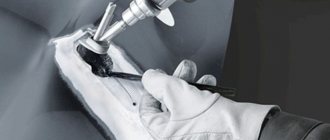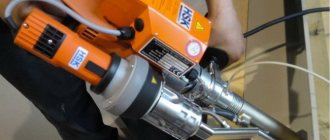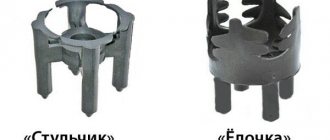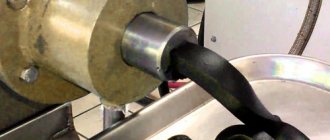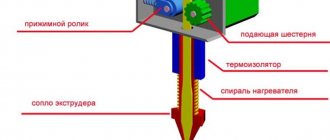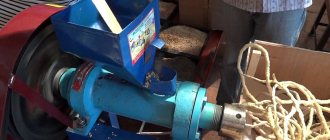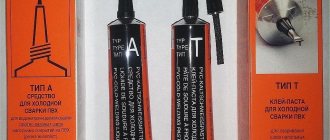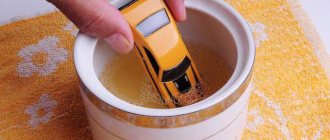The development of technological progress has led to the emergence of various technologies that make it possible to produce products with improved performance characteristics. One of the most popular processes at the moment is extrusion. It represents the technological process of processing plastics, from which various parts are made, and also various profile products are produced.
The technology itself consists of preparing an alloy from polymer materials and then pressing it through special nozzles that give it a certain shape. The main element of the line for the production of plastic products is the extruder.
Operating principle and design
It should be said that extrusion is far from a new technology. Its history goes back more than six decades. During this time, a large number of machine designs were created, with the help of which its implementation is ensured. The operating principle of this device is based on the essence of the technological process itself.
The extrusion technological process is a complex physical and chemical process, which is affected by mechanical forces under conditions of high temperature and moisture . Heating of processed products occurs due to the fact that the mechanical energy generated during the fight against internal friction, as well as during plastic deformation, is converted into heat.
There are several variable parameters during the extrusion processing process. The most important ones include:
- composition of raw materials;
- humidity;
- its nature.
During the extrusion technological process, changes may occur:
- material temperature;
- pressure;
- intensity and duration of impact on raw materials.
Extruder operating principle
In itself, such equipment is an electromechanical device, the main purpose of which is to carry out the process of molding profile parts from plastic or its semi-finished products . The general device of a plastic extruder contains the following components:
- body of the heating system for polymer materials . Conventional resistive or induction systems can act as the main source of thermal energy when carrying out this technological process. When using the latter, the occurrence of high temperatures occurs due to the induction of high-frequency Foucault induction currents onto the body;
- load node Through this element, feedstock enters the housing cavity in various ways;
- working body . It creates the necessary pressure in the equipment, which ensures the movement of raw materials directly from the loading unit to the nozzles, which form finished products from polymer materials. When using an extruder, various physical principles are used, since this device can have different designs - screw, disk, piston. At the moment, screw extruders are most often used;
- extrusion head . In another way, experts call it a spinneret. It is this that ensures the shape of the products that is obtained upon completion of the technological process;
- mechanical drive . In this equipment it is represented by a motor and a gear system. Thanks to it, the creation and transmission of the necessary force to the working body is ensured;
- control and management system . Thanks to it, the required technological regime is maintained.
The starting material is usually granules and powder . They are loaded into the equipment, and then under the action of the working element they move into the working area of the housing. There, under the influence of pressure, friction force and temperature, the feedstock supplied from outside is heated, and in the process of its melting, a state arises that is required by the conditions of the technological process.
During the movement of the feedstock in the cavity of the housing, it is thoroughly mixed to the state of a homogeneous homogenized mass.
Under high pressure conditions, the melt is forced out using forming heads and mesh filters. As a result, final homogenization is ensured and the material is given a given profile.
After this, the material is naturally cooled or a forced method is used, followed by polymerization. The end result is products that have the required configuration and have the specified mechanical and physical properties.
Why is degassing carried out during extrusion?
The quality of the finished product depends on the chemical composition and condition of the raw materials loaded into the extruder. Thermal treatment and evaporation of polymers in vacuum chambers is called degassing. After degassing, the amount of air in the granules is significantly reduced, the percentage of moisture is reduced, and the raw material gets rid of harmful impurities as much as possible.
Extruder machines equipped with screw pairs with degassing systems have special compression and expansion zones. Gaseous components in the expansion zone are removed through holes in the screw or cylinder itself using vacuum pumps. The use of such screws allows you to combine extrusion stages with simultaneous removal of gases without interrupting the entire technological process.
The sequence of operations is as follows:
- loading;
- plasticization (bringing to a homogeneous state);
- melting;
- compression;
- loosening;
- removal of volatile compounds;
- recompression;
- squeezing out the finished mass without containing gases.
If degassing is incomplete, air bubbles will remain in the molten mass. As a result, cavities, voids, and cavities are formed in finished products. Such products are defective.
Types of extruders
Modern models of extrusion plants may differ from each other both in the design of the working body and in their purpose.
Single screw
Among all types of extrusion equipment, the most common is screw. Such machines satisfy all the requirements of the extrusion process. In these units, a screw is used as the main working body. Experts call it an Archimedes screw . Many people know this working element very well from home meat grinders.
When using an extruder for the production of plastic products, the screw blade captures the raw material in the loading zone, and then it moves sequentially along the entire length of the housing cylinder, starting from the heating zone through the homogenization and molding section. Depending on the features of the technological map that the equipment has, as well as the type of raw material used for the production of products, screws can have several design options - conical, cylindrical and normal high-speed.
Augers that taper toward the exit can also be used. For this equipment, experts consider the ratio of the working diameter of the screw and its length as the main parameter. Augers also differ in the pitch of the turns and their depth.
The main disadvantage of a single screw extruder is that it is not always possible to use them. For example, if semi-finished powder products are used as the starting raw material, then the presence of one screw in the equipment does not allow mixing the mass during the process of its melting and subsequent homogenization. In such cases, the choice is made in favor of twin-screw extruders.
Twin screw
The peculiarity of this equipment is that its screws are interlocked. Therefore, when using such extruders, it is possible for the screws to perform parallel and counter rotational movements. These working parts of the equipment can be straight or conical.
The use of such machines leads to the fact that during the heating process of the feedstock, its mixing and homogenization is carried out more thoroughly. Ultimately, a homogeneous and degassed mass arrives at the head for molding products.
The following point should be noted: in certain technological processes, extruders with a larger number of screws can be used - up to 4. In addition, a planetary automatic machine is often used, when the number of screws rotating around the central screw reaches 20.
The need to use such equipment arises when certain types of plastics are used as feedstock, which tend to break down when exposed to high temperatures. In other words, they may lose their basic physical qualities. Thus, the use of such extruders ensures heating of raw materials due to friction and high pressure.
Working cylinder
- Heating zones: 3
- Heating power consumption (maximum): 11.7 kW
- Air cooling: 2 zones
The extruder screws are located in the working cylinder. The cylinder is made of high-strength steel; corrosion-resistant bimetallic sleeves are inserted inside the cylinder. The cylinder body is connected to the die using a special flange. The housing is heated by resistance heaters. To remove excess heat and maintain the desired temperature regime, an air cooling system is used, consisting of fans, an air duct system and dampers.
Production of PVC profiles
Currently, plastic and composite profiles are in demand. In most cases, manufacturers make them using the extrusion method. To manufacture such products, depending on the material used, as well as the complexity and shape of the product, single- or twin-screw machines are used, which have corresponding molding heads.
The range of products produced using extruders is quite wide, ranging from thin threads and strips to sheets of large panels that have a profile of complex geometry. Plastic windows and doors, produced today by many companies, are assembled using PVC profiles, which are made on extrusion equipment.
When producing PVC profiles, many manufacturers add special components to the polymer composition, which makes it possible to produce complex composites. For example, today many manufacturers produce wood-plastic products, which are often used for the manufacture of various building structures.
Coronary polymer treatment
Chemically inert surfaces of polymer products produced by extrusion, as a rule, do not form strong compounds with printing inks. When inks, adhesives or dyes are applied to non-porous surfaces, the liquid is not absorbed, but collects in drops and flows off instantly.
For the production of polyethylene packages with drawings and advertising inscriptions, extrusion lines are equipped with special devices for processing the film with corona discharge in order to increase its adhesive properties. The surface energy of films that have undergone electromagnetic corona treatment increases and becomes 7-10 dynes/cm higher than the surface tension of liquid media. As a result of microetching, smooth surfaces with an activated structure are well wetted and are ready for painting, gluing, flexo printing, applying bright patterns and other types of processing.
Pipe manufacturing
In an area such as the production of tubular products, an important condition is the absence of gas bubbles in the homogenized mixture. For this reason, manufacturers equip extruders that are used in the production of such products with degassing systems. In most cases, screw installations are used. Among other things, barrier screws are used, which ensure reliable separation of the solid semi-finished product from the completely melted one. Due to this, the homogeneity of the composition is maintained, which has a positive effect on the quality of the manufactured pipe products and its performance characteristics.
Market Review
According to data for 2022, about half of all garbage in Russia was plastic, most often packaging from various goods, which collectively amounts to more than 40 million tons.
The plastic processing sector in the country is at the formation stage. The prospects are great, the Russian state increasingly understands that the problem with waste needs to be solved, and not by burying or burning it in landfills, but through secondary recycling. Less than 10% of the country's total plastic waste is recycled. The rest is buried in landfills or burned.
Even despite the absence of a separate waste collection system - the main problem of the industry - the market is growing: it now exceeds $2 billion. A businessman, with the right organization of the business, can get a good margin with the support of the state and take a rightful place in the emerging industry.
Extruders for polyethylene
All films made from polymer materials are produced by companies exclusively using the extrusion method. To produce such products, a blow molding extruder is used. For equipment used for the production of stretch film, the forming unit may look like a narrow slit. When using such equipment, the output is a single-layer film that has the required thickness and width parameters.
Some models may use round slotted dies of large diameter. When using mini-extruders, it is possible to obtain film with a sleeve width of up to 300 mm and a thickness of 600 microns. Such devices have compact sizes, which makes them possible to install even in a small room.
Extrusion lines
In industrial settings, extrusion equipment should be considered as the main component of the line for the implementation of this process. In addition to the main equipment - the extruder, it also includes a whole set of other mechanisms and devices:
- winding and cutting mechanisms. They are used to bring products into the form required for warehousing and transportation;
- marking and laminating systems of various operating principles;
- mechanisms for drawing finished profiles;
- cooling system. Its installation is carried out at the exit of the extruder in order to increase the speed of the polymerization process of finished products. These systems can be of various types - air or in the form of a cooling bath;
- raw material preparation and loading system. In some cases, the semi-finished product must first be subjected to a drying procedure and subsequent calibration before feeding it into the loading hopper.
Other mechanisms can be used as part of the equipment, as well as technological devices can be used to automate the continuous production process.
Profitable proposition
Polimermash-Service LLC offers on favorable terms the purchase of a single-screw extruder for polymer processing, as well as a number of other production equipment in demand on the market. The Company's production facilities are located in Penza
region, but extruders and lines are sold to any city and region of the country. We are ready to offer each client of the company high-quality, reliable and inexpensive equipment for polymer processing.
Each installation, before going on sale, undergoes load testing, checking reliability and operating efficiency. As an additional service, we carry out a range of works to prepare extruders and production lines for commissioning. If necessary, the company’s engineers will conduct training for the customer company’s personnel.
It is profitable to cooperate with us. Contact us, gentlemen entrepreneurs!
Summing up
Extrusion technology is quite popular nowadays. It is used in the production of various products. It is mainly used for the manufacture of plastic products. Plastic windows and doors, familiar to everyone in our country, are made using this process. To produce products, a device such as an extruder is used. This equipment has a simple design, so making an extruder for plastic with your own hands is a completely feasible task.
The peculiarity of this process is the preheating of the raw material, which is then subjected to a melting procedure under conditions of a certain temperature and pressure. Next, the polymer mass is pressed through molding nozzles, which makes it possible to obtain products with the desired physical and qualitative characteristics.
Features of polymer extrusion
Extrusion technology follows the following algorithm:
- The granules are poured into the machine's hopper.
- The heating turns on.
- The particles melt and form a homogeneous viscous mass, which is the prototype of the future PE film.
For melting, different types of polymers are used, differing in melting temperature. In particular, polyethylene melts at 100-125 °C. Polypropylene - at 80-170°C. Such a wide melting temperature range is due to the presence of various additives in its composition.

